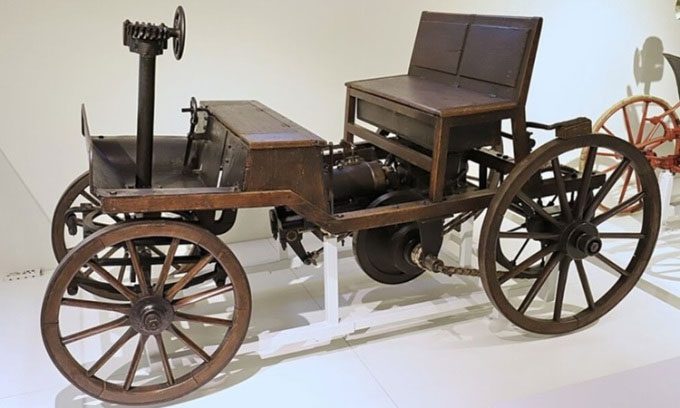The first gasoline-powered car was invented by Austrian inventor Siegfried Marcus in 1875, though he is often overlooked in automotive history.
A frequently ignored name in the history of the automobile industry is Siegfried Marcus, the Austrian inventor who designed and operated a four-stroke gasoline-powered vehicle approximately 10 to 15 years before Gottlieb Daimler, Wilhelm Maybach, and Carl Benz brought their utility vehicles into operation. While this trio is typically regarded as the pioneers of the automotive industry, Marcus’s contributions deserve equal recognition, according to Amusing Planet.

Siegfried Marcus’s second vehicle at the Vienna Technical Museum. (Photo: Wikipedia).
Siegfried Marcus was born on September 18, 1833, into a Jewish family in Malchin, which is now located in the northwest of Berlin, Germany. At the age of 12, he began working as an apprentice mechanic. Five years later, he joined a telecommunications engineering company. When he turned 19, Marcus moved to Vienna, the capital of the Austrian Empire, and started working as a technician at the Medical Physics Institute. He later became the assistant to physiologist Professor Carl Ludwig. In 1860, he started his own business, opening a factory for electrical and mechanical equipment, which he managed until the end of his life. Marcus’s inventive spirit led him to hold 131 patents in 16 countries.
Around 1860, Marcus began creating the first self-propelled vehicle. At that time, regions of Austria, now part of Poland, started producing petroleum. The refining process yielded kerosene, lubricating oil, and gasoline as byproducts. Marcus experimented with gasoline and discovered that when dispersed in air, it could ignite, creating explosive energy. This breakthrough led to the world’s first carburetor, which Marcus patented in 1864.
For his first vehicle, Marcus fitted a two-stroke internal combustion engine that used gasoline as fuel to a crude four-wheeled cart, connected to the rear wheels. The vehicle needed to be started by lifting the two rear wheels off the ground and spinning them by hand. Once ready to roll, the vehicle was lowered to the ground and allowed to run on its own. Marcus dismantled this vehicle as it was too bulky and focused his efforts on refining the design. The second vehicle, created in 1875, was notable for being equipped with a four-stroke gasoline engine, a new carburetor, and a mechanical ignition system using a spark. This vehicle could reach a maximum speed of 16 km/h.
Marcus likely also built a third and fourth vehicle. These later versions were upgraded, integrating steering mechanisms, brakes, clutches, and various other necessary equipment. However, these vehicles did not survive to the present day. Only the second vehicle remains intact, preserved under the ownership of the Austrian Automobile Club and displayed at the Vienna Technical Museum.
Marcus passed away in 1898. As a Jewish man, he became a victim of the propaganda campaign orchestrated by the Nazis. His inventions were destroyed, his name erased from educational materials, and public memorials to him dismantled. In July 1940, the German Ministry of Propaganda sent a letter to the management of Daimler-Benz A.G. in Stuttgart, instructing them to remove Siegfried Marcus’s name from the Meyers Lexikon and Grosse Brockhaus encyclopedias, replacing it with Gottlieb Daimler and Carl Benz in the role of automobile inventor.
The Nazis also ordered the destruction of Marcus’s vehicle exhibited at the Vienna Automobile Club. Fortunately, some members of the Vienna Trade and Industry Museum anticipated this and hid the vehicle behind a wall in the museum’s basement. Thanks to this foresight, the vehicle was safely preserved along with some records of his inventions.


















































